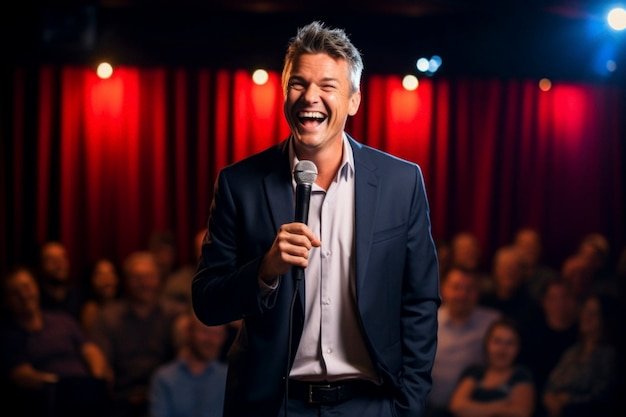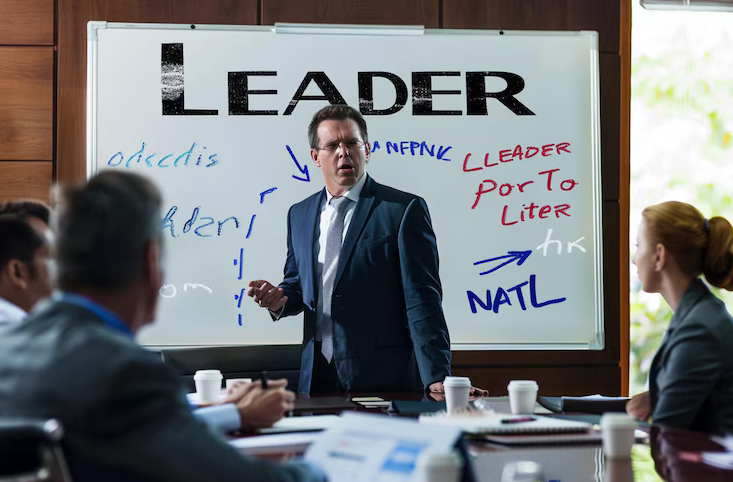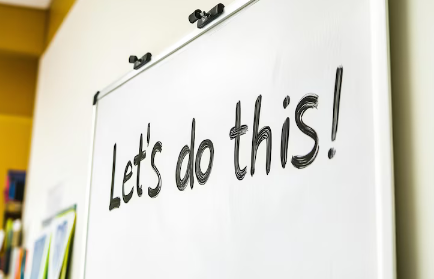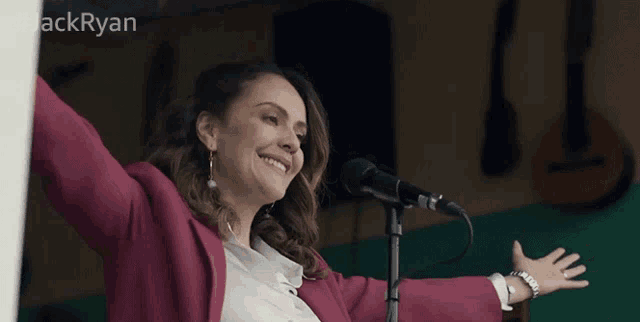Tips and techniques for successful public speaking
-
Svetlana Sibiryak
Copywriter Elbuz
A pounding heart, trembling hands, dry lips... Who doesn't know that feeling of horror before going on stage? The inevitable moment when it is your turn to speak is approaching every second. But what if there is a way to change this?

Glossary
- 🎤 Public speaking is the process of conveying information to a group of people for the purpose of informing, persuading or entertainment.
- 🫣 Glossophobia is the fear of speaking in public, one of the most common phobias in the world.
- 💡 Visualization technique is a preparation method that involves mentally imagining the success of a future performance to reduce stress levels.
- 🪶 Presentation - a set of slides, visuals, or other graphic resources that accompany a speaker's speech.
- 👥 Mentor is an experienced individual who provides support and advice to improve your public speaking skills.
- 📣 The voice is a speaker's tool, important for conveying emotions and attracting the attention of the audience.
- 🪞 Rehearsing in front of a mirror is a technique that allows you to observe your gestures, facial expressions and improve the expression of your thoughts.
- 🗂️ Topic – the main idea or subject that will be discussed during a public speech.
- 📝 Speech text - a prepared script or the main points that the speaker plans to make.
- 🧩 Cheat sheet – a short set of key words or phrases that helps you navigate important information during a speech.
- ⏳ Allotted time – a set time interval within which the speaker must fit his speech.
- 😃 Audience sympathy - a positive attitude of listeners towards the speaker, helping to establish contact and trust.
- 😄 Emotions are a means of influencing the audience through the sincere expression of feelings and experiences.
- 🌀 First Phrase Technique - Using a catchy or emotionally powerful phrase at the beginning of a speech to capture the audience's attention.
- ⌛ Pause is a short-term silence in speech that attracts attention and emphasizes important points.
- 🎨 Plan A – the main scenario of the speech.
- 🔢 Speech points are logically structured parts of a speech that make it easier to perceive and remember information.
- 😆 Joke is a humorous statement used to lighten the atmosphere and create a more friendly contact with the audience.
- 💧 Water is an important attribute of a speaker, helping to maintain the voice and cope with anxiety.
- 🤝 Feedback - evaluation or comments on a speech received from the audience or colleagues to improve skills.
- 🙋♂️ Answering questions is a process of interacting with the audience after a speech, involving clarification or discussion of the topics raised.
- 🙏 Gratitude – an expression of gratitude to listeners for their participation and attention.
- 👂 Listening to other speakers is a way to improve your skills and find new ideas for your speeches.
Find a mentor
When I started my career, I had no confidence in speaking in front of an audience. The first step to overcoming my fears was finding the right mentor. Whether you have problems with diction, lack confidence, or just stage fright, getting help from a competent professional can make all the difference.

🎙️ Personally, I turned to a speech therapist who helped me get my voice right and improve diction. The example of the film "The King's Speech", in which the main character copes with his speech difficulties, inspired me to find a professional.
🤝 If you are worried about self-confidence, I can recommend consulting with a psychologist. The rest of my success came from observing successful speakers. For example, watch Tony Robbins's performances and study his technique, facial expressions and gestures.
How to do it:
- 📚 Find a speech therapist or psychologist with good reviews.
- 📺 Watch successful speakers and note their techniques.
- ✍️ Practice the techniques you've learned in your performances.
Real life example: I observed Tony Robbins and his way of communicating with an audience. These observations helped me create my own communication style.
| Action | Helpful | Not Helpful |
|---|---|---|
| Consultation with a speech therapist | ✅ | ❌ Speech therapist no experience |
| Contact a psychologist | ✅ | ❌ Incompetent psychologist |
| Performance observation | ✅ | ❌ Purely theoretical |
Voice Training
One of the fundamental foundations of speaking confidently is using your voice correctly. I can say with confidence that without a well-produced voice it is impossible to win the attention of the audience.

🎤 Let's talk about technique. I try to speak with my diaphragm rather than my vocal cords, which not only improves my diction, but also increases the length of my performances without fatigue. Before each performance, I sing repeatedly, just as singers do before a concert.
🎵 To get the desired result, I stretch my neck, straighten up and read tongue twisters. Moreover, I use the emotional coloring of my voice to make my words sound more lively and aimed at the audience.
Practical steps for voice training:
- 💬 Speak with your diaphragm.
- 🎵 Sing before your performance.
- 👂 Listen to your voice on the recording and analyze it.
Personal example: once before an important performance, I practiced speaking with my diaphragm and singing tongue twisters. This helped me sound confident and convincing.
| Action | Helpful | Not Helpful |
|---|---|---|
| Diaphragm voice training | ✅ | ❌ Speak only in combinations |
| Pre-show break-in | ✅ | ❌ Complete disregard for preparation |
| Emotional coloring of speech | ✅ | ❌ Monotonous voice |
Rehearsals in front of a mirror
Effective preparation for public speaking is impossible without repeated rehearsals. When I'm preparing for an important performance, I always practice in front of the mirror. This helps me analyze my gestures, facial expressions and posture.

👁️ For example, I have found that crossing my arms and legs reveals my insecurity. More details, rehearsals helped me become aware of the nonverbal signals I was sending to the audience and learn to control them.
👥 An interesting idea is to rehearse in front of friends. I often organized mini-conferences with the participation of close people. They gave me honest feedback which helped me improve my performance.
Preparation process:
- 🪞 Rehearse in front of the mirror.
- 🤸 Analyze your non-verbal signals.
- 👥 Conduct rehearsals in front of a small audience.
Example from practice: I practiced in front of the mirror and noticed my incorrect gestures. This allowed me to speak more confidently in front of large audiences.
| Action | Helpful | Not helpful |
|---|---|---|
| Rehearsal in front of the mirror | ✅ | ❌ Complete lack of rehearsals |
| Analysis of non-verbal signals | ✅ | ❌ Ignore facial expressions and gestures |
| Rehearsals with friends | ✅ | ❌ Ignore feedback |
Think about the topic of your speech
The topic of your speech should be interesting and relevant to the audience. I always focus on what the listeners really care about. For example, if I speak to students or young startups, I often share personal stories and real-life cases.

📈 In my practice, there was once a successful case when I increased the profits of an Internet store 5 times. This particular example was illustrated with detailed steps to help the audience understand the concept better.
❌ Don’t forget about your listeners and overload them with dry facts and statistics. Less theory - more practical skills and personal stories!
How to think about a topic:
- 🎯 Determine the interests of the audience.
- 📚 Use personal stories and examples.
- 📉 Avoid too much theory and statistics.
Example from experience: at one of the lectures I talked about real cases of increasing revenue in my business, which interested the audience and sparked a lively discussion.
| Action | Helpful | Not helpful |
|---|---|---|
| Taking into account the interests of the audience | ✅ | ❌ Ignoring audience |
| Personal examples and stories | ✅ | ❌ Predominance of theory and numbers |
| Mini-cases and practical skills | ✅ | ❌ Too much boring information |
Write the text of the speech
For me, preparing the text of the speech begins with thoughts about those who will be with me listen. I strive to make the speech as interesting and useful as possible for the audience.

📋 It is important to remember the key rules: talk about what is interesting to your listeners, share personal experiences and stories. In my practice, I always try to include as much useful information as possible and minimize boring statistics.
👂 In one of my speeches, I used rhymes and wordplay to make the speech more memorable and lively. Example: "We must follow the principles of HUMANISM, not bureaucracy."
Writing process:
- 👍 Think about your listeners.
- 📝 Include personal stories and examples.
- 🎤 Use rhymes and puns.
Example from a talk: I talked about my personal path to success in the Internet business, which allowed the audience to better understand and remember my advice.
| Action | Helpful | Not Helpful |
|---|---|---|
| Taking into account the interests of the audience | ✅ | ❌ Ignoring audience |
| Using personal stories | ✅ | ❌ Prevalence of boring data |
| Use of rhyme and wordplay | ✅ | ❌ Too complicated language |
Visualization of material
I am convinced that visualization plays a key role in a successful presentation. Creating a quality presentation helps keep your audience's attention and makes information more accessible.

📊 In my practice, I always use PowerPoint or its equivalent. I try to put more visual content on each slide than text. These can be graphs, tables, photographs and infographics.
🌈 When I design a presentation, I take into account the corporate identity, including logos, brand fonts and colors. This helps maintain a consistent style and professional appearance.
Steps to create a visualization:
- 📷 Use graphs, tables and photographs.
- 🎨 Maintain your corporate identity.
- 📉 Make each slide meaningful and concise.
At one of the events, I used a bright presentation with a lot of graphs, illustrations and a minimum amount of text. This allowed the audience to focus on the most important aspects.
| Action | Helpful | Not Helpful |
|---|---|---|
| Content visualization | ✅ | ❌ Complete absence graphics |
| Corporate identity accounting | ✅ | ❌ Ignoring the company's style |
| Laconic slides | ✅ | ❌ Overloaded slides |
Speech Cheat Sheet
Even the most prepared speaker can forget his speech. In such cases, I always prepare a cheat sheet with the main points and key points. This helps to maintain confidence and not get discouraged during the performance.

🗒️ It is important not to read the text from the cheat sheet, but to use it as a guide. In my practice, I prepare short notes that help me navigate the material and speak in my own words.
Creating a cheat sheet:
- ✍️ Prepare your main points.
- 🗂️ Use notes for orientation.
- 🎤 Don't read the text verbatim.
Personal example: I always prepare short notes before speaking. This helps me stay confident and speak freely.
| Action | Helpful | Not Helpful |
|---|---|---|
| Abstract preparation | ✅ | ❌ Complete absence cheat sheets |
| Using notes | ✅ | ❌ Sight reading |
| Speak in your own words | ✅ | ❌ Monotonous reading of text |
Audience Engagement: Secrets of a Successful Presentation
📅 Follow allotted time
I always tell myself, “Time is golden.” One of the key rules for a successful presentation is to strictly adhere to the allotted time. I once spoke at a conference and realized how important it was to complete my speech on time. My speech fit perfectly into the framework, and the organizers nodded to me in gratitude when I finished.

I advise you:
- ⏰ Rehearse your performance in advance to meet the allotted time.
- 💼 Use a timer or clock to keep track of time during your presentation.
- 📊 Plan the structure of your speech and leave some time for questions.
😌 Gain sympathy for yourself
One day I was speaking in front of a new audience and I felt incredibly excited . I decided to start with a confession: “This is my first time in front of such a large audience, so please don’t judge.” You should have seen how this immediately calmed the situation! I insist: be sincere. If you are a beginner, don't hide it.
- 🧑🤝🧑 Admit your excitement - this will cause sympathy.
- 🙋♀️ Ask for support from the audience.
- 🛋 Just one confession can bring you closer to your listeners.

🌟 More emotions
Monotony is the enemy of engagement. I once attended a speech where the speaker spoke without emotion, and even I, with my professional interest, began to get bored. Turn your performance into living history. Let your feelings come out in your voice. When I talked about my difficult experience starting a project, people really looked into my soul. They loved hearing about the challenges and victories.
- 😊 Weave emotion into your speech.
- 🔥 Remember your personal feelings when telling stories.
- 💬 Share difficulties and recipes for overcoming them.
📝 Use the technique of the first phrase
An exciting introduction is the key to success. When I open my talk with a quote from a great person or an interesting story, the audience immediately pays attention to me. For example, in one of my talks I started with a quote from Mark Twain: “Buy land, because no one else is making it.” This piques interest and keeps listeners focused.

- ✍️ Start with a strong quote.
- 📜 Use intrigue or news.
- 🔊 Ask your audience a question to hook them right away.
🤔 Take a pause
The right pause is magic. In one of my talks, I paused for a few seconds before a key thought. Those present literally froze in anticipation. Remember that silence sometimes speaks louder than speech.
- 🤫 Use pauses to emphasize important points.
- ⏸ Pausing before keywords enhances their impact.
- 🗨 Silence attracts attention and encourages reflection.
👤 Plan A
Personal contact is powerful. In one of my talks, I found an acquaintance in the audience and addressed him as if I were having a conversation with a friend. This gave me confidence and made the performance process easier.
- 😊 Find a pleasant listener and imagine that you are talking to him.
- 📛 Use familiar faces to create a comfortable atmosphere.
- 💬 Include your audience in the dialogue, but be careful not to confuse people.
📜 Break your speech into bullet points
Structured information is easier to perceive. When our listeners see a clear structure, it is easier for them to follow the flow of thought. When I divided my talk into small logical blocks, people thanked me for the clarity and convenience.

- 📂 Break your speech into bullet points.
- 🖊 Help listeners take notes.
- 📑 In the final slide, summarize the results and points of the entire speech.
😂 Make jokes
Humor is a great ally. I remember how much the atmosphere changed when I inserted little jokes. One day I told about a funny situation at work, and the room burst into smiles.
- 😂 Tell realistic and relatable jokes.
- 🪄 Rehearse your jokes in advance so they sound natural.
- 🎭 Humor relieves tension and brings you closer to the audience.
🌊 Don't forget water
Once, when I was speaking at a long seminar for the first time, my my throat began to dry out. Since then I always take a small bottle of water with me. This is a small but very important aspect.
- 💧 Keep a bottle of water handy.
- 🥤 Wet your throat to prevent drying out.
- 🚰 Drinking water helps preserve your voice.

👐 Don't forget about non-verbal cues
Everything is important here: from gestures to posture. I always try to keep my hands visible, not hide them, so that the audience feels my openness and sincerity.
- 🙌 Gesture moderately.
- 🧍 Maintain a confident posture with your shoulders back.
- ☝️ Use your hands to emphasize your words.
Ultimately, a successful presentation is a combination of good preparation, emotional involvement and the ability to connect with the audience. I believe that by using these techniques in your presentations, you can greatly improve your public speaking skills and leave a lasting impression on your audience.
Helpful tips:
- Rehearse your speech.
- Include emotions and humor.
- Stick to the set time.
Don't:
- Ignore the structure of the speech.
- Taking up more time than allotted.
- Leave your hands in your pockets or behind your back.
We conclude the presentation: we answer questions 📢
After your main monologue is completed, the tension does not disappear, but moves into a new phase. Now comes the part that may be difficult for many - answering questions from the audience. I can confidently say that this stage is critical to a successful presentation. This is where you prove your competence and ability to improvise. Let's figure out how to make it as effective as possible.
.png)
💬 Give us feedback
One of the most pleasant and useful moments after a performance is communicating with the audience. Don't be afraid to ask questions, even if you don't know the exact answer. I would advise lightening the situation with humor. So, there is a simple and effective way to deal with difficult questions: invite a partner or assistant and redirect the question to him. There is nothing wrong with this, and you can always say that you have a delineation of responsibilities. You will feel more comfortable - confidence will come by itself.
What really helps in such situations is:
- 😎 Support from the audience: Having a colleague who can come to your aid takes away a lot of the stress.
- 👍 Show calm: Even if the whole room is looking at you expectantly, remain confident.
- 😂 Using humor: A simple, funny response sometimes works best.
❓ What to do if there are no questions?
A situation where no one asks questions can be a dead end. I can assure you that this does not mean failure at all. There are two possible options: either everything was clear, or the audience simply did not get involved in the process. As a way out: prepare a couple of questions in advance. I recommend asking questions of yourself or asking the audience to share their experiences.

From personal experience, I always had a few prepared questions at hand. For example:
- 🌟 "What do you think of our approach to solving the problem?"
- 🤔 "Do you have experience using such methods?"
Feel free to reach out to your friends in the room. This will help enliven the conversation and create more engagement.
😊 Thank
I think a sincere "thank you" is always appreciated. After your speech, thank the audience for their attention and express your hope to see them again. It would be helpful to provide your contact information so that you can continue the conversation privately. Personally, I always give listeners the opportunity to receive a copy of my presentation - a great way to build rapport.
Very important:
- 📧 Leave your contact information: social networks, phone number, email address mail.
- 💌 Offering Materials: Handing out a presentation or any other material reinforces your professional image.
- 😊 Sincerity: gratitude should certainly be felt.
📚 Listen to other speakers
Once your talk ends, don't rush to leave. Breaks and coffee breaks are a great chance to get to know each other, discuss impressions and exchange business cards. I encourage you to use this time to expand your contacts. After all, informal communication opens up many new opportunities.

In my experience, the most important thing in these situations is:
- 🤝 Make contacts: you shouldn’t leave, leaving the audience without your participation.
- 👥 Participate in discussions: by communicating with other participants, you will not only strengthen your knowledge, but also increase your network of useful contacts.
- ✅ Keep track of your promises: If you promise to send a presentation, do it. A self-respecting speaker always keeps his word.
Useful tips and tricks
Useful practices:
- 🌈 Bring a partner or assistant to the event for support.
- 💡 Always have a few questions ready to liven up the discussion.
- 💌 Sincerely thank the audience and leave your contacts.
- 🤝 Participate in informal communication with other speakers and participants.
What to Avoid:
- ❌ Panic when asking difficult questions.
- ❌ Disorientation in the absence of questions.
- ❌ Formalities for gratitude.
- ❌ Quick departure from the event.
Using these tips, you can improve your public speaking and make it more effective and memorable for your audience. Remember that public speaking is not only about you, but also about your ideas that can inspire and help others. Good luck building your confidence and skills!

Experience Siemens company
Company Siemens is a global corporation specializing in the development and implementation of innovative solutions in the field of electronics, automation and digitalization . With a tradition dating back to the mid-19th century, Siemens is committed to improving people's lives and making industrial processes more efficient.

Main tasks and goals of the project
For the company Siemens the key tasks were:
✅ Introduction of advanced techniques and technologies in organizing public speaking by employees .
✅ Ensuring a confident and professional representation of the company at major international conferences and exhibitions.
✅ Increasing the level of involvement and interest from potential partners and clients.
Main problem
Main problem was lack of employee confidence when performing at major events. This factor negatively impacted the brand perception and corporate reputation of Siemens.
Characteristics and interests of the target audience
The target audience consisted of:
🤝 Investors interested in technological innovation.
🤝 Partners assessing the prospects for cooperation with Siemens.
🤝 Competitors keeping track of the company's latest developments.
🤝 Customers who want to receive maximum information about products and services.
They all showed special interest in:
📊 Technological novelties and innovations.
📊 Practical examples of successful implementations.
📊 Long-term strategy and development prospects of the company.

Interesting and important points for potential clients
📝 Preparation for speeches included:
- Improving public speaking skills.
- Preparation of materials and presentations.
- Rehearsals in front of a mirror and a live audience.
- Thorough visualization of information.
📝 During the performance the following were used:
- Good speaker.
- Performance time control.
- Using emotional elements.
- Clear structuring of speech.
- Witty jokes to lighten the situation.
📝 After the performance:
- Audience feedback .
- Answers to questions from participants.
- Providing contact information.
"Siemens employees have gained confidence and become more effectively present the latest technologies. We have improved brand perception in the market and gained the trust of new investors." - says one of the project leaders, Josef Kramer.
These results showed a significant improvement in quality and confidence in public speaking of Siemens employees, which increased the overall level of brand perception and the effectiveness of interaction with the audience.
Related FAQ: Tips and Techniques for Successful Public Speaking
Thank you for reading and for becoming more advanced 📚
Congratulations 🎉! You are now a true expert at overcoming your fear of public speaking. Having learned the main reasons for fear and mastered the proposed techniques, you are ready to conquer any audience. Don't forget, confidence and preparation are your main allies. Practice, improve and don't be afraid of anything. Well, I, Svetlana Sibiryak, am always happy to share my knowledge. Leave your comments and share your successes!
Always yours, Svetlana Sibiryak.
🌟 "The magic of words in the symphony of online store automation. Join my guiding text course into the world of effective online business!" 🌟

Article Target
Help readers overcome their fear of speaking in public and learn how to effectively present their ideas.
Target audience
Students, professionals, aspiring speakers, and anyone with public fear.
Hashtags
Save a link to this article
Svetlana Sibiryak
Copywriter ElbuzThe magic of words in the symphony of online store automation. Join my guiding text course into the world of effective online business!
Discussion of the topic – Tips and techniques for successful public speaking
The main reasons for fear of public speaking, effective techniques for overcoming it, tips on how to prepare for a successful speech, even if you really don’t want to.
Latest comments
15 comments
Write a comment
Your email address will not be published. Required fields are checked *




















Emily
Cool tips! But it seems to me that breathing exercises are the most important thing. When you start breathing correctly, fear goes away by itself.
Johann
Emily, I completely agree! It also helps to imagine that the audience is in something ridiculous. For example, in funny hats 😂
Sophie
Johann, oh yes! It definitely helps you relax. I also noticed that if you rehearse your performance with one or two close friends in advance, this also reduces your stress level.
Carlos
Sophie, rehearsal is definitely the key! Recently, I tried recording myself and watching the video. Helps see things from the audience's perspective.
Francesco
Svetlana Sibiryak, do you have any other tips on how to deal with tremors in your voice? This is my main problem.
Светлана Сибиряк
Francesco, voice tremors can be reduced with a vocal warm-up exercise. Sing and say tongue twisters before your performance. It really works!
Anna
Another good way is to learn the first few phrases by heart. You start confidently, and the fear recedes.
GrumpyOldMan
This is all nonsense. Previously, there was no such fear; we performed without any techniques. Now they are just making things up.
Olaf
GrumpyOldMan, times change and so do methods. Perhaps these techniques would become obsolete if they were not effective. By the way, visualizing a successful performance also helps me.
Julia
Olaf, yes, visualization is power! And it also helps me to imagine that I have already performed and everything went with a bang. It somehow relieves the tension.
Елена
Julia, super strategy! Have you ever had such cases when everything did not go according to plan?
Julian
Elena, of course, everyone has such cases. But the main thing is not to panic. Improvisation sometimes takes performance to the next level.
Светлана Сибиряк
Julian, absolutely right! Improvisation and the ability to keep a cool head are the keys to a successful performance. Practice and practice again.
Mateusz
Does anyone use meditation to combat stress before a performance? It helps me focus.
Johann
Mateusz, I tried it a couple of times, but I never got used to it. Although, I’ve heard that it really helps a lot of people!